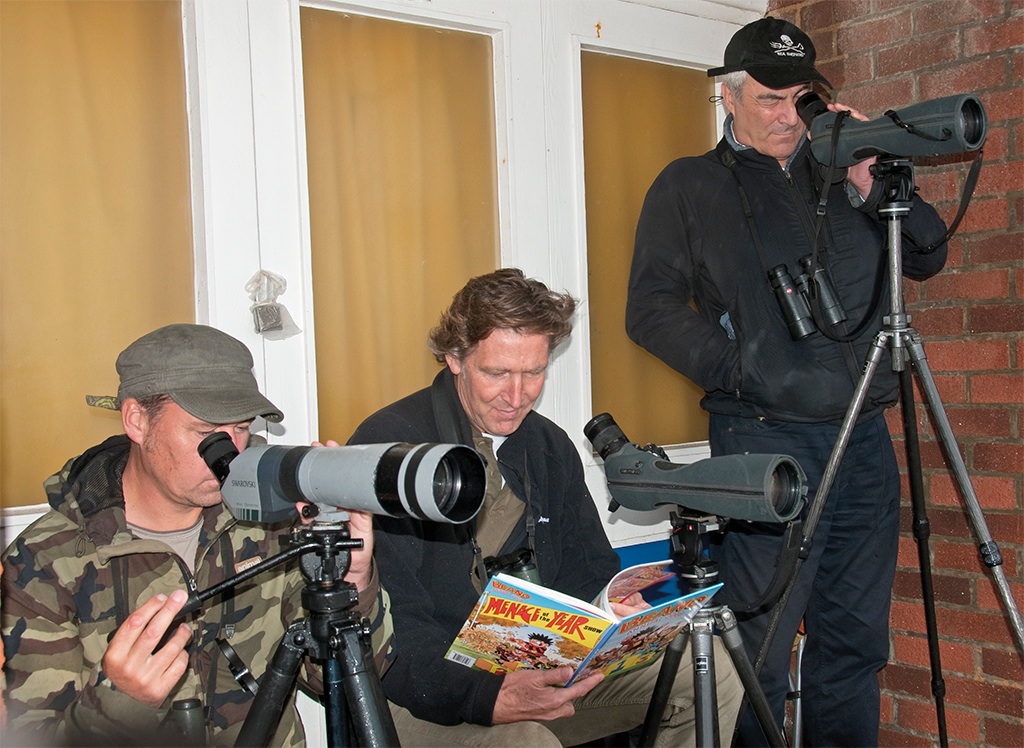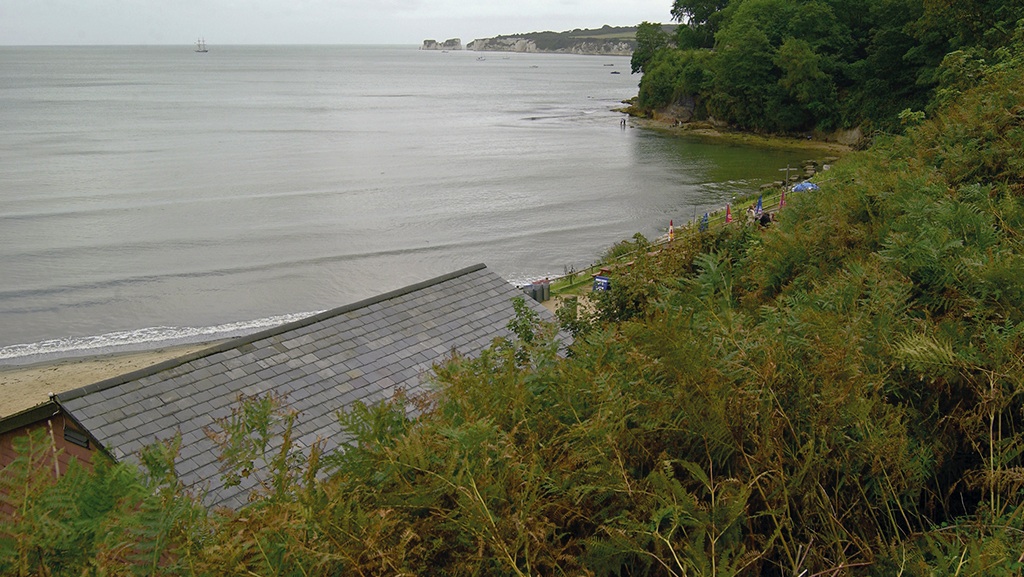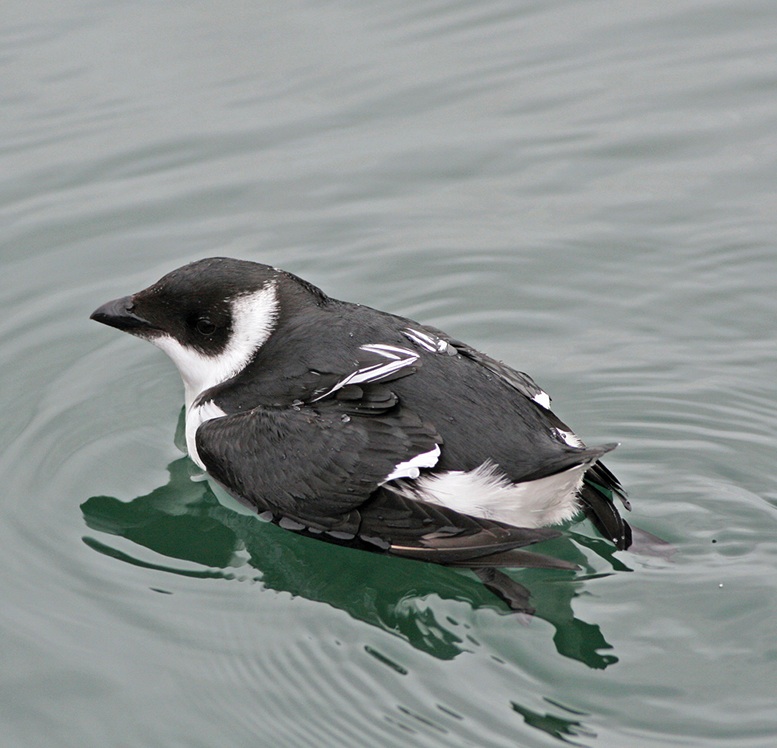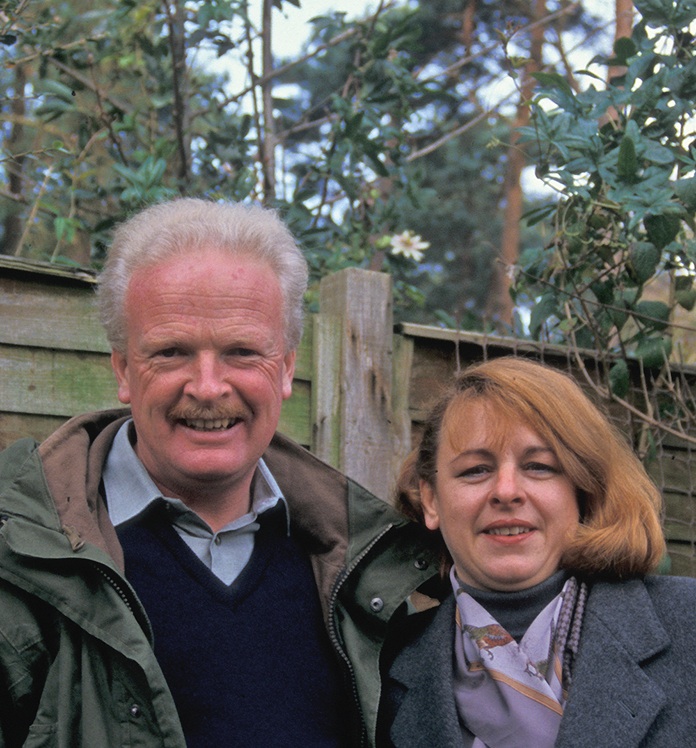It’s early November, 08:40 in the morning, and overcast. We’re seawatching. I’m perched on my stool looking through my scope. Graham Armstrong is sitting on one side, Mo on the other.
I pick up what at first appears to be a tiny falcon, compact and flying purposefully about five metres above the waves, range 200 to 300 metres and moving west across the bay. Graham gets onto it and says, “It’s a petrel.”
Mo sees it as well. I increase my concentration. It has no head markings and looks all-dark. This is not like any petrel I’ve ever seen here, neither British Storm Petrel nor Leach’s Storm Petrel. Its flight is more direct and the wind doesn’t seem to affect it. I watch it for what seems like an eternity, hoping for the blinding light of recognition…
In reality the whole episode must have lasted just 3 or 4 minutes as it flew towards Studland before continuing over the waves and out of sight. Adrenalin crashed through my system, and as I sat crumpled on my tiny stool I must have looked awful. My nerves weren’t robust enough for an all-dark petrel. Graham looked away. Mo said, “If someone else saw you like this they would get you to hospital. Come on, I’ll take you home.”
Branksome Chine is to blame. You can sit there for days on end watching nothing but the sea. If you are lucky you have company. Over the years I have discussed how to ripen avocados in a paper bag with Iain Prophet, the Beano with Killian, and the standards of cleanliness at the nearby public toilets with Shaun. Pulse rates are somewhere close to an iguana’s when suddenly there’s a good bird and everyone experiences a level of excitement that would put an astronaut’s constitution under strain.

Seawatching, from left to right Nick Hopper, Killian Mullarney and Mark Constantine, Branksome Chine, Poole, Dorset, 25 August 2010 (Arnoud B van den Berg)
It was Graham who invented Branksome as the local seawatching site. He also made Leach’s Storm Petrel the bird we all wanted to see. During a gale on Christmas Eve 1989, he saw 30 of them off Branksome. At the time he lived a short walk from the chine, so when he got home he phoned Roger and Ewan, who rushed down there seeing somewhere between 40 and 50 Leach’s in an hour. That inspired the rest of us.
Branksome lies half way between the harbour mouth and Bournemouth pier, at the bottom of orange sandy cliffs, and it has facilities. A car park, some toilets, a café, and beach huts, the porches of which offer us shelter in all but direct southerly gales. There is also the lady who picks up dog poo but doesn’t have a dog, the spartan swimming sisters who first thing every morning go for a swim in horrid conditions, and the cyclist passing in a red frogman’s outfit complete with flippers and mask. On the way down the path we have seen a lady in her pyjamas cutting a hedge with a pair of scissors. That’s because at the top of the cliff is St Anne’s Hospital, “serving the needs of people with severe and enduring mental illness”.
Nick hates seawatching here. It’s right on the promenade, with locals and tourists constantly passing. Some stare quizzically and others come over. “What are you all looking at?” is the usual question. “Nothing,” is the honest reply, so they nod, smile and walk on. Seawatching is like that. I had a call from Barbara, Hamish’s wife, during one seawatching season. She said, “I’m very worried about Hamish’s mental health. For days now he’s been standing on the edge of a cliff wearing three pairs of trousers in the most appalling conditions.” I told her that was quite normal and not to worry.

Seawatching point at Middle Beach car park, looking towards Old Harry, Dorset, 23 August 2004 (René Pop)
There isn’t any other easy place to go seawatching from Poole Harbour. On dry days you can be up on Ballard Down squinting into the sunlight miles above the sea, trying to tick a Glaucous Gull off Swanage. Nick prefers the National Trust car park at Middle Beach, overlooking Studland Bay. “Its better for shearwaters,” which can be dots from Branksome. Balearics can glide through here, and on one July evening he counted 93 Manx Shearwaters pass close by in just over 30 minutes, a harbour record. Writing this, I started to think of the cost so I phoned Nick.
“What about the car park fees when you watch from Middle Beach?”
“It’s free if you are in the National Trust.”
“Are you in the National Trust?” I find myself innocently saying as the penny drops.
“Well, I was…” and we start to giggle.
One morning, I was watching with Shaun at Branksome, while Nick was sitting by his car up on Middle Beach, no doubt keeping one eye out for the National Trust parking attendant. It was fairly quiet until we picked up a Pomarine Skua slowly making its way west, occasionally dropping onto the water. I rang Nick and asked if he could see it. “No,” was the reply, “I can’t see that far into the bay. But no bother, it has to come out this way.” While Nick was patiently waiting, it lifted up off the sea and began circling to gain height. Then it turned north and flew inland, straight over Poole town. To add insult to injury, Shaun swears that it flew right over Nick’s former house.
Pomarine Skuas are actually quite well known for crossing over land. On 26 May 2002, a very similar thing happened. Stan was seawatching off Branksome when he saw six ‘Poms’ moving slowly west. They also spent some time on the sea, allowing Nick and James just enough time to get there from home and see them head inland over Studland, before being lost very high over the Purbeck ridge.
During strong easterlies, all sorts of birds can completely miss out Durlston and Purbeck, sneaking through the harbour mouth and the southern half of the harbour, then generally nipping out through Middlebere. Over the years this has created a series of seabird records in weird places. More noteworthy ones include a Fulmar west over Stoborough and another found grounded on a pavement in Wareham after a heavy hailstorm. Occasionally a stray Gannet also heads up the Middlebere channel and across to Gad cliff and the sea, and there have been several records of Sabine’s Gull in the southern parts of the harbour.
The most celebrated case was on 31 August 1998, a bird race day with very strong easterlies. At 8:15, Jackie and Mo were at the main hide overlooking Little Sea when they were surprised to see a skua flying across Godlingston. I was cycling nearby with my son Jack when it flew directly over my head. I tried to memorise some features as it went over. Straining my neck and not looking where I was going, I soon ended up in a heap on the path. After I had picked myself up, I rang Killian. I described the barred underparts and remembered seeing a pale nape. He immediately suggested juvenile Long-tailed Skua.
About four hours later, Shaun and Roger were standing at Hartland Moor when Roger shouted, “Skua!” They then watched in amazement as a pale-morph Long-tailed Skua flew out of the Middlebere channel and across the heath, right in front of them.
I must admit to being rather glad Nick likes seawatching at Middle Beach as he can turn up some good birds lingering in the bay. On 30 October 2007 after a quiet seawatch, he had just started his survey of the bay when he came across “two fat-headed scoters with pale face patches”. He immediately thought Surf Scoters, but because of their distance and lack of any nape patches he needed to rule out odd-looking juvenile Velvet Scoters. These niggles soon disappeared when the birds began to drift in, confirming the head and bill shape and revealing the strongly capped appearance of juvenile Surf Scoter. Mo and I were there in a jiff and enjoyed close views of two great birds.
James Lidster, Graham, Mo and I finally caught up with Leach’s Storm Petrel after 12 years of drought at Branksome on 2 February 2002, when a lovely close Leach’s was seen by all of us. Shaun had been packing for a holiday when he got the call, and rushed down. He was soon sniping way to the west and was rewarded when he picked up another distant Leach’s heading towards us. Eventually it made its way slowly past an awestruck line of us, giving perfect views. Shaun whooped and even Nick, who had just arrived, gave a little cheer.
With the internet and flexible work schedules, it is now easier to experience a wreck of Leach’s Storm Petrel. While working on this book, Magnus and I were having our elevenses and reading our emails when I read that Roger Howell had just seen five Leach’s off Mudeford quay near Christchurch. At 12:00, we heard that Cliff Rogers had seen 20 in half an hour at Abbotsbury. We went to Branksome for lunch. When we arrived, two Great Skuas were close in harassing the passing Kittiwakes, then Magnus saw the first Leach’s at what must have been 13:00. In the next hour and a half, we saw 10 Leach’s struggling against a strong south-westerly gale and even some hailstones. Nick (still trying to avoid Branksome) was photographing another two birds hanging around the harbour mouth. By late afternoon all the Leach’s had gone, and there were none the next day.

Little Auk Alle alle, Brownsea, Poole, Dorset, 13 November 2007 (Kevin Lane)
You don’t need bad weather to watch Poole’s seabirds. Most summers, a company of Gannets fishes off Sandbanks. Fulmars breed secretly up on the cliffs at Ballard among the Shags and cormorants. We don’t have any nesting auks, although Razorbill and Guillemot can normally be found in the bay and up to Poole Quay outside of the breeding season. Puffin is rare, really rare. None of us has ever seen one in the harbour. Little Auk is far easier to see.
Little Auks occur most years in November and while waiting for one to pass Branksome, Mo and I had a conversation with bachelor Graham about his dog. I think we had just watched a flock of scoters flying past when he told us of his problem. He said that as he lived with his parents, they normally looked after his dog when he went on trips across the globe looking at seabirds. Since his mum had died, his father had remarried and the new stepmother was less obliging. His dog had been given to a new home.
During the course of that month he updated us on the state of affairs. Between watching the Fulmars glide by and identifying small parties of Arctic Terns, he explained that he was now buying his dad’s house while his dad was moving into his new wife’s home. This still left Graham with a problem. He wanted to get a new dog but now that he was living alone, who would look after it when he was away? I suggested that he found someone to look after the house, keep it clean and look after his dog when he was away.
Seawatching is very seasonal. We watch in spring in the hope of seeing Pomarine Skua and then look for a variety of species during the autumn windy season from late August to November. So it was in the spring six months later when I was able to ask him, “Did you get another dog?” “No”, he told me. “Couldn’t you find someone to help with the house?” “Yes,” he blushed. “Her name’s Marie and she’s moved in. I don’t think I’m going to be bothering about getting a dog”. I met Marie sometime later and then again in a crowd at the Bird Fair. I was surprised to feel my bottom pinched and turned to find that she was the culprit, beaming alongside Graham.

Graham Armstrong and Marie Hobby, Poole, Dorset, August 1998 (Anonymous)
Marie encouraged Graham to go to musicals. So now while we are waiting for something good to pass we can compare the relative merits of Les Miserables and Miss Saigon. That’s when we are not thinking of the dark-rumped petrel, and how Nick pointed out that one of the last strange ‘petrels’ at sea in Dorset turned out to be a Nightjar.